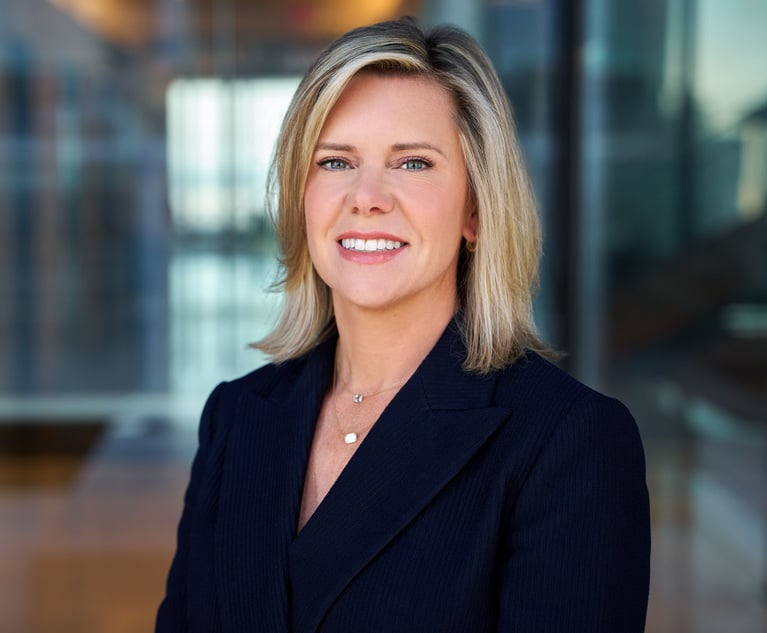Sills Cummis & Gross Moves Up in Legal World With Strong 2018 Performance
The midmarket law firm has not yet broken into the Am Law 200 but that could change in the next few years if it continues its steady growth.
February 11, 2019 at 05:11 PM
4 minute read
The original version of this story was published on New York Law Journal
 Max Crane of Sills Cummis & Gross/courtesy photo
Max Crane of Sills Cummis & Gross/courtesy photo
Riding the wave of a strong economy, midmarket law firm Sills Cummis & Gross has reported gross revenue of $90.2 million for the 2018 fiscal year, up from last year's figure of $87.9 million.
The firm has fallen short of making it to the Am Law 200 but if it continues its steady financial growth, it could win entry to the list in the next few years.
The firm also reported revenue per lawyer of $663,000 for fiscal year 2018 compared with $656,000 for a year earlier. Its profits per partner came to $885,000, up from $879,000 the previous year. The firm's head count grew slightly to 136 lawyers firmwide, including 63 partners, compared with 134 lawyers and 61 partners in fiscal 2017.
“It was a very successful year. I wish I could take all the credit, but the general state of the economy, the quality of our lawyers, and luck were all factors,” said Max Crane, the firm's managing partner.
Much of the firm's growth rests on its core practice areas of litigation, general corporate transactional work, real estate, and bankruptcy and restructuring, Crane said. Those practices and the bankruptcy practice, in particular, were in strong demand throughout the year.
The firm has income rather than equity partners and eschews lockstep compensation for its partners in favor of a highly entrepreneurial system that incentivizes the originators of business, Crane noted.
One step that Crane says undoubtedly helped grow business over the past year was the luring of James Tyrrell, a commercial litigator with a focus on toxic torts whose extensive resume includes practicing law at Latham & Watkins, Squire Patton Boggs, and Locke Lord. Highlights of Tyrrell's legal career include acting as lead counsel for New York City in the protracted litigation over the World Trade Center catastrophe and advising SEACOR in the aftermath of the Deepwater Horizon disaster.
Indeed, the law firm's growth rests heavily on the luring of highly sought-after legal professionals such as Tyrrell rather than a sudden and massive expansion through tie-ups with competitors. Even as one midsized law firm after another gets swept up in the merger wave, Crane denies that Sills Cummis has been in merger talks in recent months.
“We have tried to grow incrementally and organically by bringing in lawyers by the ones and twos and in small groups, rather than looking for a 'home run' which might put our profitability at risk and our internal culture at risk. We do like to grow, but we're not looking for one swing of the bat to change our dynamic,” Crane stated.
Asked whether merger talks might be a possibility in the future if the right offer came along, Crane replied, “I never say never.”
In an age of unremitting pressure on rates, Sills Cummis has been open to alternative fee arrangements for some of its clients.
“We're really guided by the client. You have to be. If a client wants an alternative rate, we will take a look at it,” Crane said.
Crane considers the lawyers' fees at his firm to be a bargain for many clients given the alternative. If the clients went to one of the marquee names in the legal world, they could easily pay $1,200 an hour for a partner's services and $700 an hour for the help of a second-, third-, or fourth-year associate. At Sills Cummis, the latter rate can get clients the attention of a talented partner, Crane said.
Crane added that he expects the firm's deliberate, measured growth to continue through 2019 and beyond.
“We believe that life's a marathon, not a sprint. Slow and steady wins the race,” he said.
This content has been archived. It is available through our partners, LexisNexis® and Bloomberg Law.
To view this content, please continue to their sites.
Not a Lexis Subscriber?
Subscribe Now
Not a Bloomberg Law Subscriber?
Subscribe Now
NOT FOR REPRINT
© 2025 ALM Global, LLC, All Rights Reserved. Request academic re-use from www.copyright.com. All other uses, submit a request to [email protected]. For more information visit Asset & Logo Licensing.
You Might Like
View All
Arizona Supreme Court Presses Pause on KPMG's Bid to Deliver Legal Services

Adding 'Credibility' to the Pitch: The Cross-Selling Work After Mergers, Office Openings
5 minute readTrending Stories
Who Got The Work
J. Brugh Lower of Gibbons has entered an appearance for industrial equipment supplier Devco Corporation in a pending trademark infringement lawsuit. The suit, accusing the defendant of selling knock-off Graco products, was filed Dec. 18 in New Jersey District Court by Rivkin Radler on behalf of Graco Inc. and Graco Minnesota. The case, assigned to U.S. District Judge Zahid N. Quraishi, is 3:24-cv-11294, Graco Inc. et al v. Devco Corporation.
Who Got The Work
Rebecca Maller-Stein and Kent A. Yalowitz of Arnold & Porter Kaye Scholer have entered their appearances for Hanaco Venture Capital and its executives, Lior Prosor and David Frankel, in a pending securities lawsuit. The action, filed on Dec. 24 in New York Southern District Court by Zell, Aron & Co. on behalf of Goldeneye Advisors, accuses the defendants of negligently and fraudulently managing the plaintiff's $1 million investment. The case, assigned to U.S. District Judge Vernon S. Broderick, is 1:24-cv-09918, Goldeneye Advisors, LLC v. Hanaco Venture Capital, Ltd. et al.
Who Got The Work
Attorneys from A&O Shearman has stepped in as defense counsel for Toronto-Dominion Bank and other defendants in a pending securities class action. The suit, filed Dec. 11 in New York Southern District Court by Bleichmar Fonti & Auld, accuses the defendants of concealing the bank's 'pervasive' deficiencies in regards to its compliance with the Bank Secrecy Act and the quality of its anti-money laundering controls. The case, assigned to U.S. District Judge Arun Subramanian, is 1:24-cv-09445, Gonzalez v. The Toronto-Dominion Bank et al.
Who Got The Work
Crown Castle International, a Pennsylvania company providing shared communications infrastructure, has turned to Luke D. Wolf of Gordon Rees Scully Mansukhani to fend off a pending breach-of-contract lawsuit. The court action, filed Nov. 25 in Michigan Eastern District Court by Hooper Hathaway PC on behalf of The Town Residences LLC, accuses Crown Castle of failing to transfer approximately $30,000 in utility payments from T-Mobile in breach of a roof-top lease and assignment agreement. The case, assigned to U.S. District Judge Susan K. Declercq, is 2:24-cv-13131, The Town Residences LLC v. T-Mobile US, Inc. et al.
Who Got The Work
Wilfred P. Coronato and Daniel M. Schwartz of McCarter & English have stepped in as defense counsel to Electrolux Home Products Inc. in a pending product liability lawsuit. The court action, filed Nov. 26 in New York Eastern District Court by Poulos Lopiccolo PC and Nagel Rice LLP on behalf of David Stern, alleges that the defendant's refrigerators’ drawers and shelving repeatedly break and fall apart within months after purchase. The case, assigned to U.S. District Judge Joan M. Azrack, is 2:24-cv-08204, Stern v. Electrolux Home Products, Inc.
Featured Firms
Law Offices of Gary Martin Hays & Associates, P.C.
(470) 294-1674
Law Offices of Mark E. Salomone
(857) 444-6468
Smith & Hassler
(713) 739-1250












